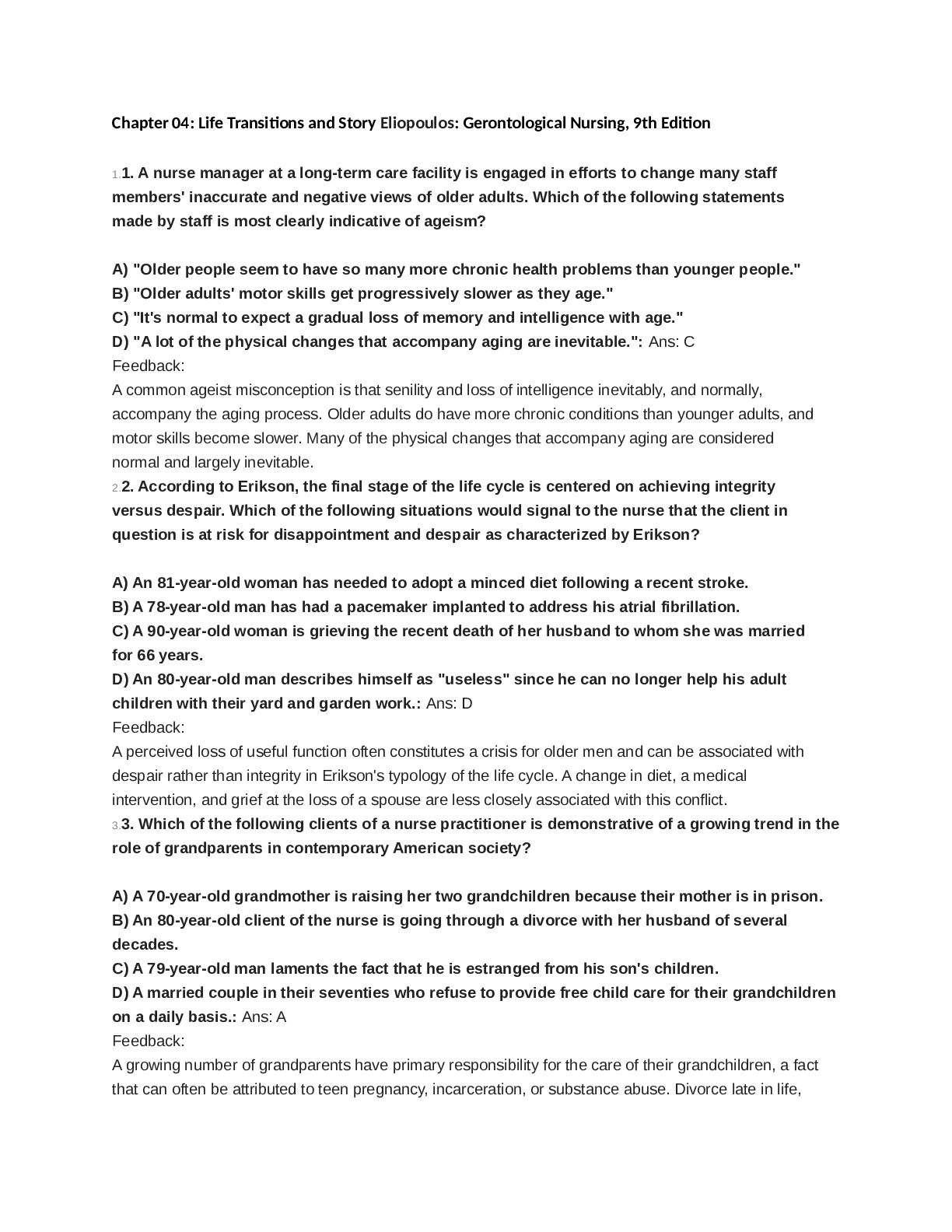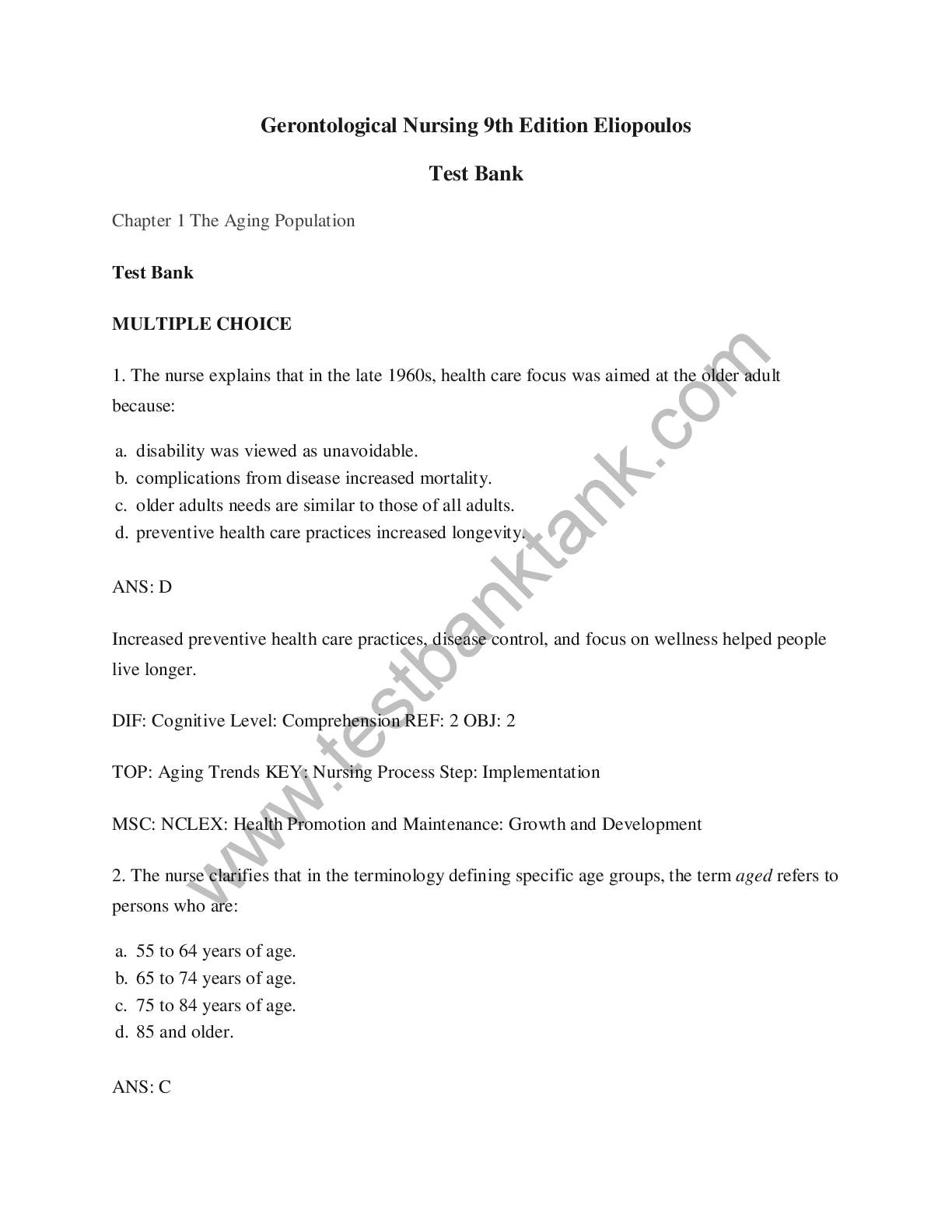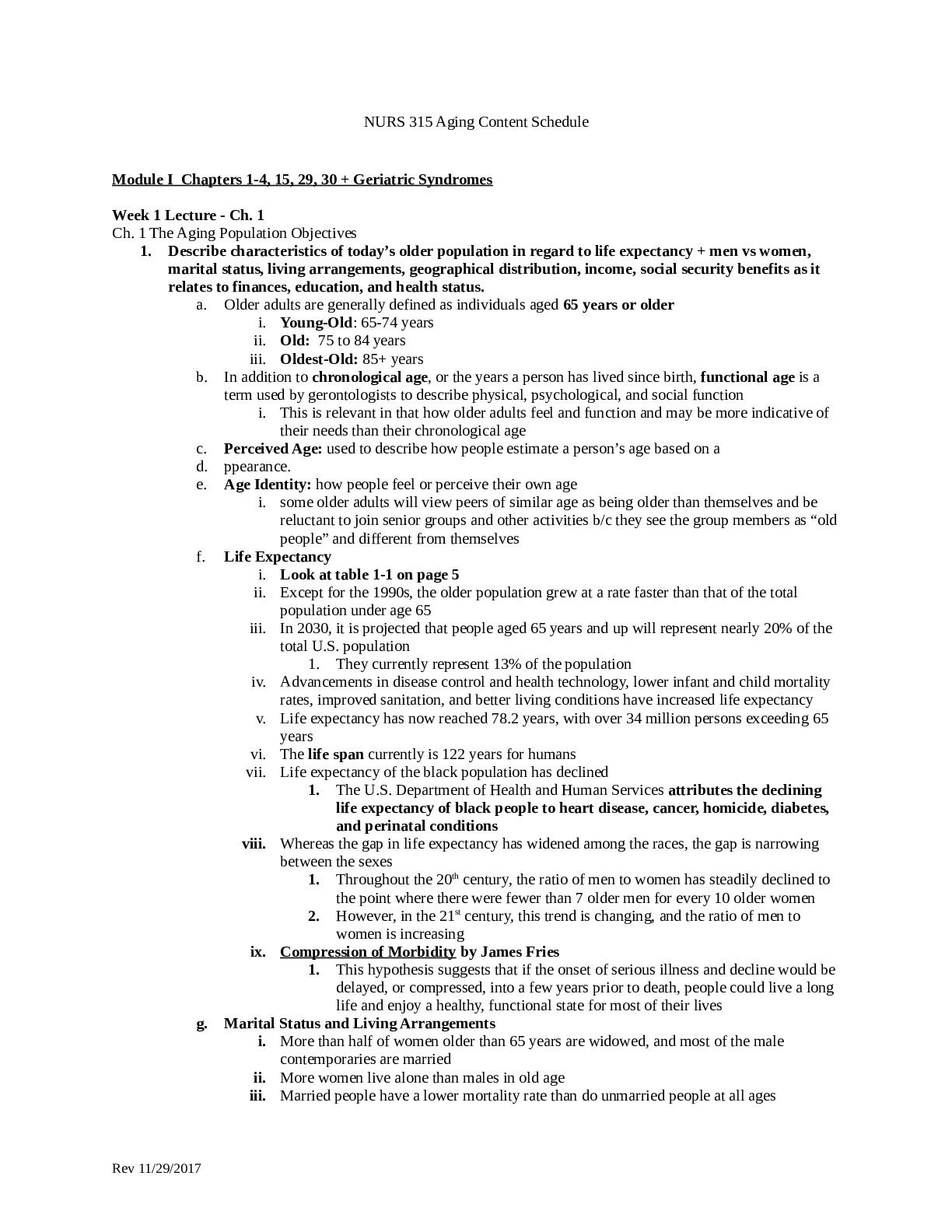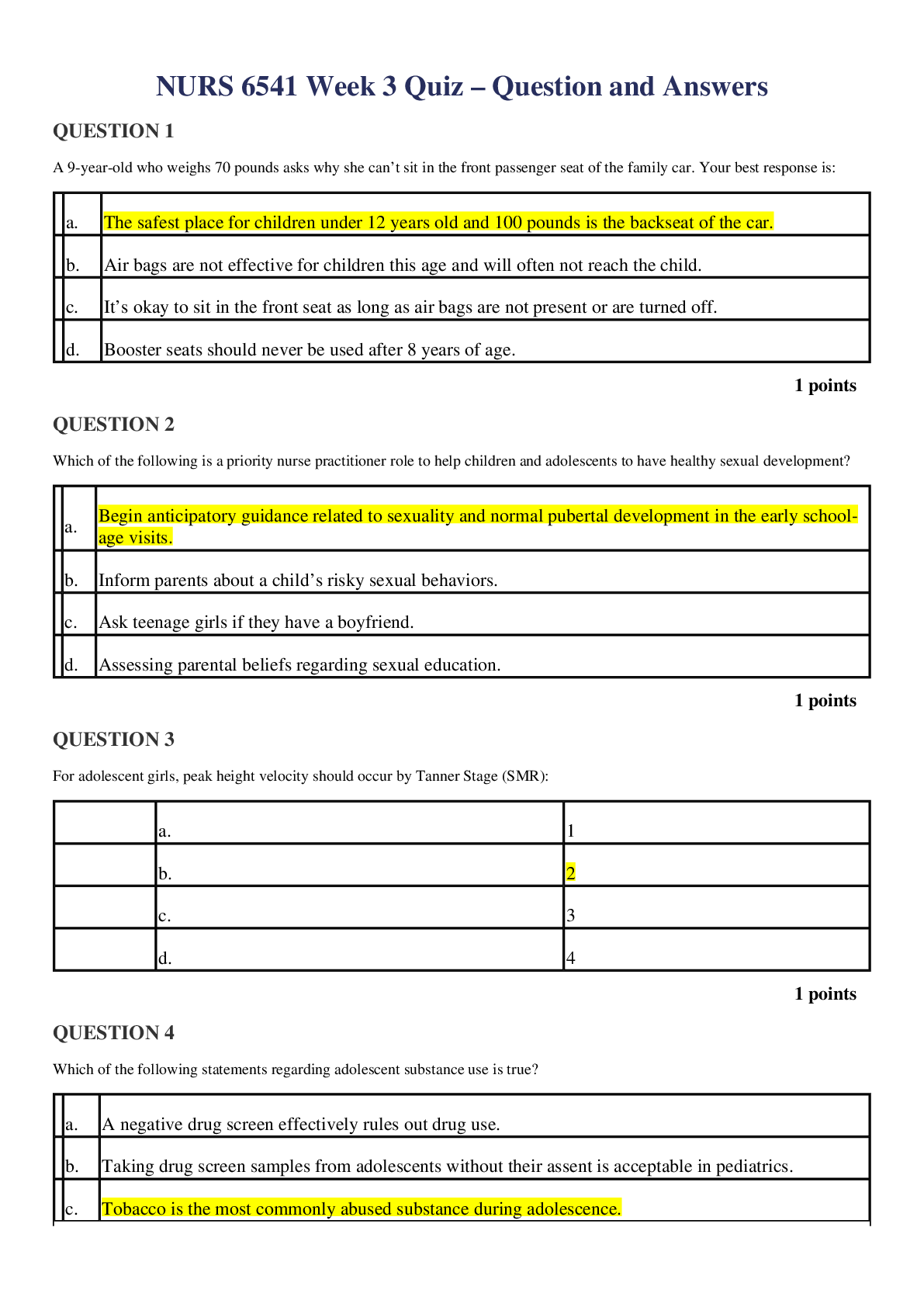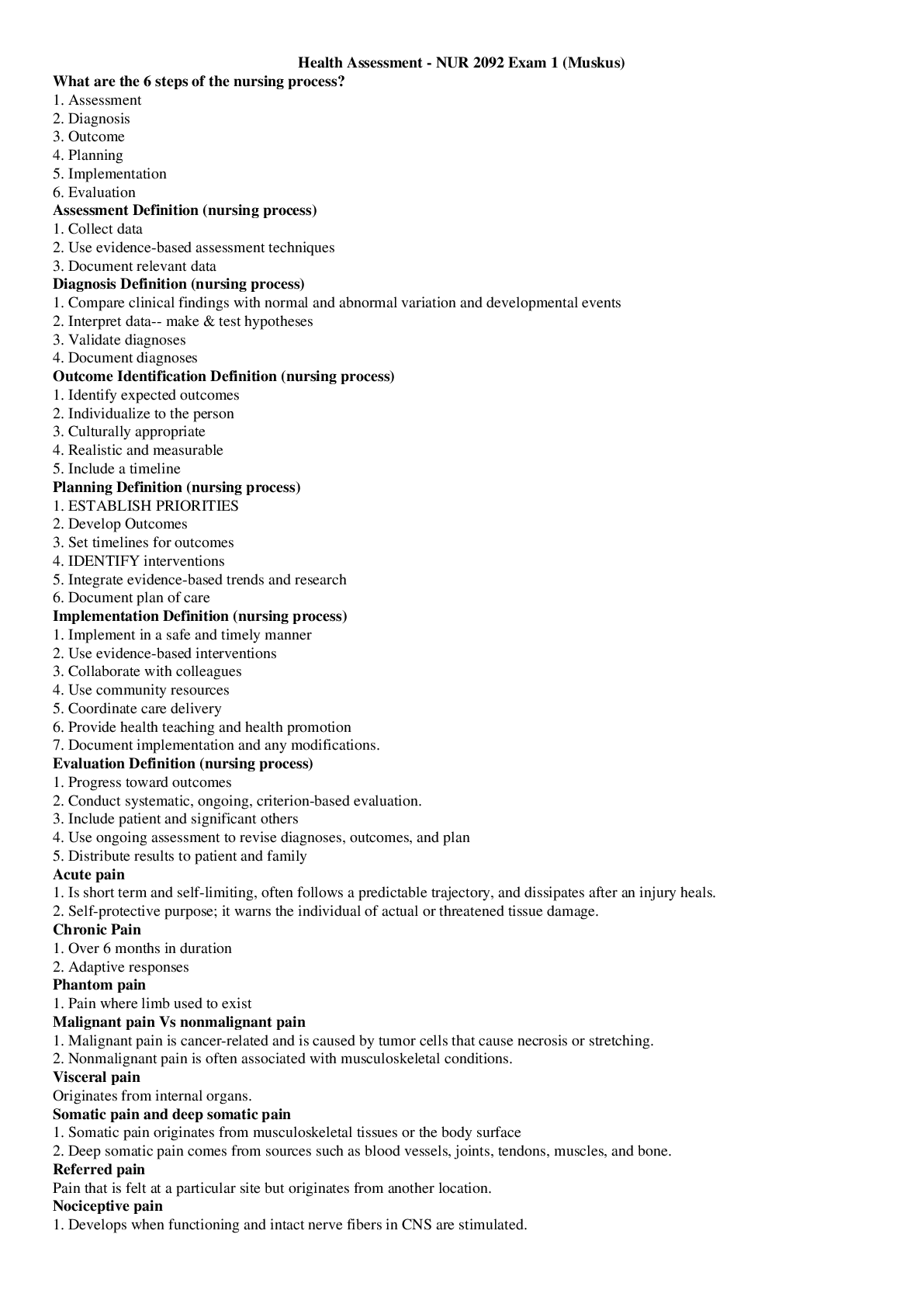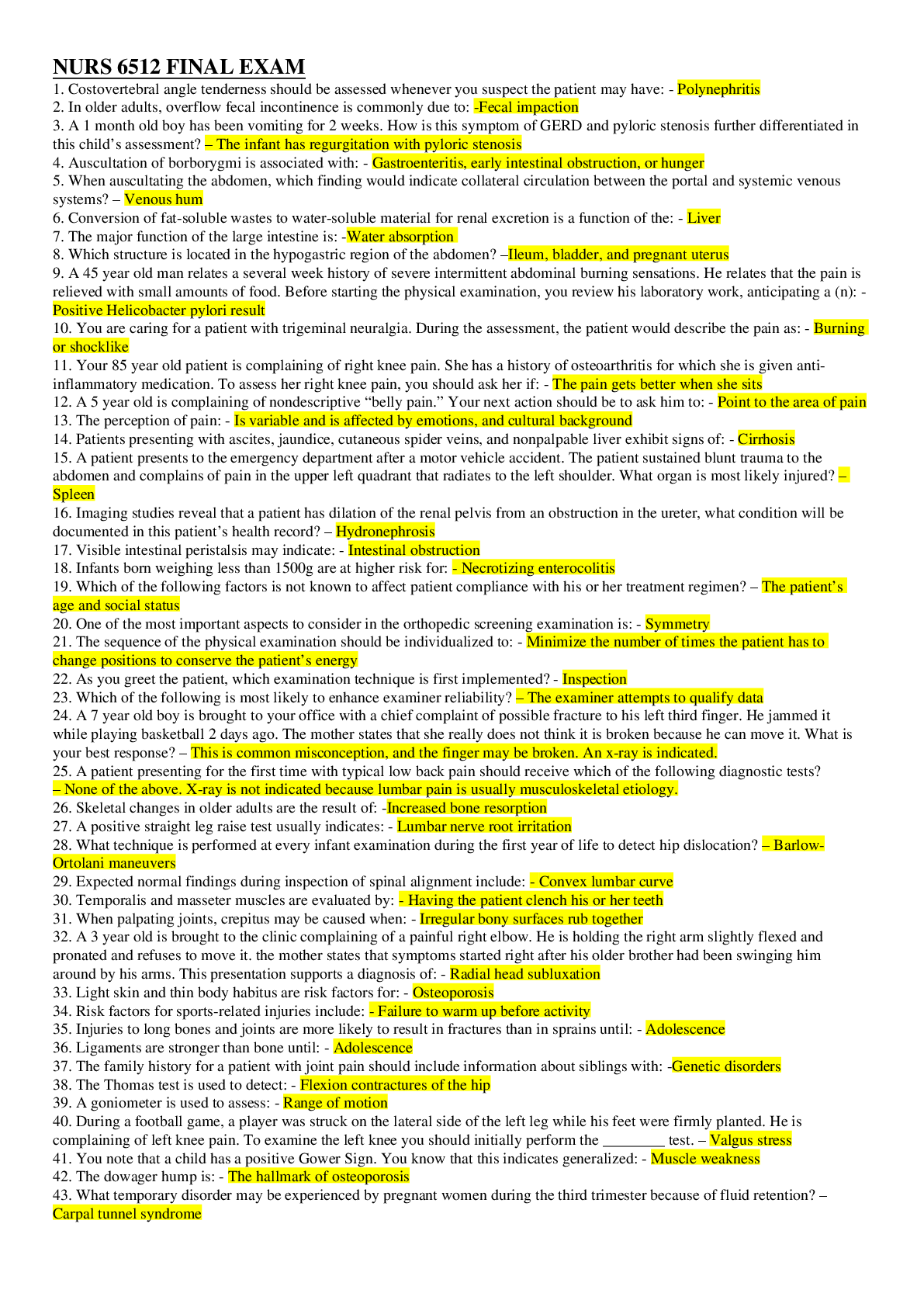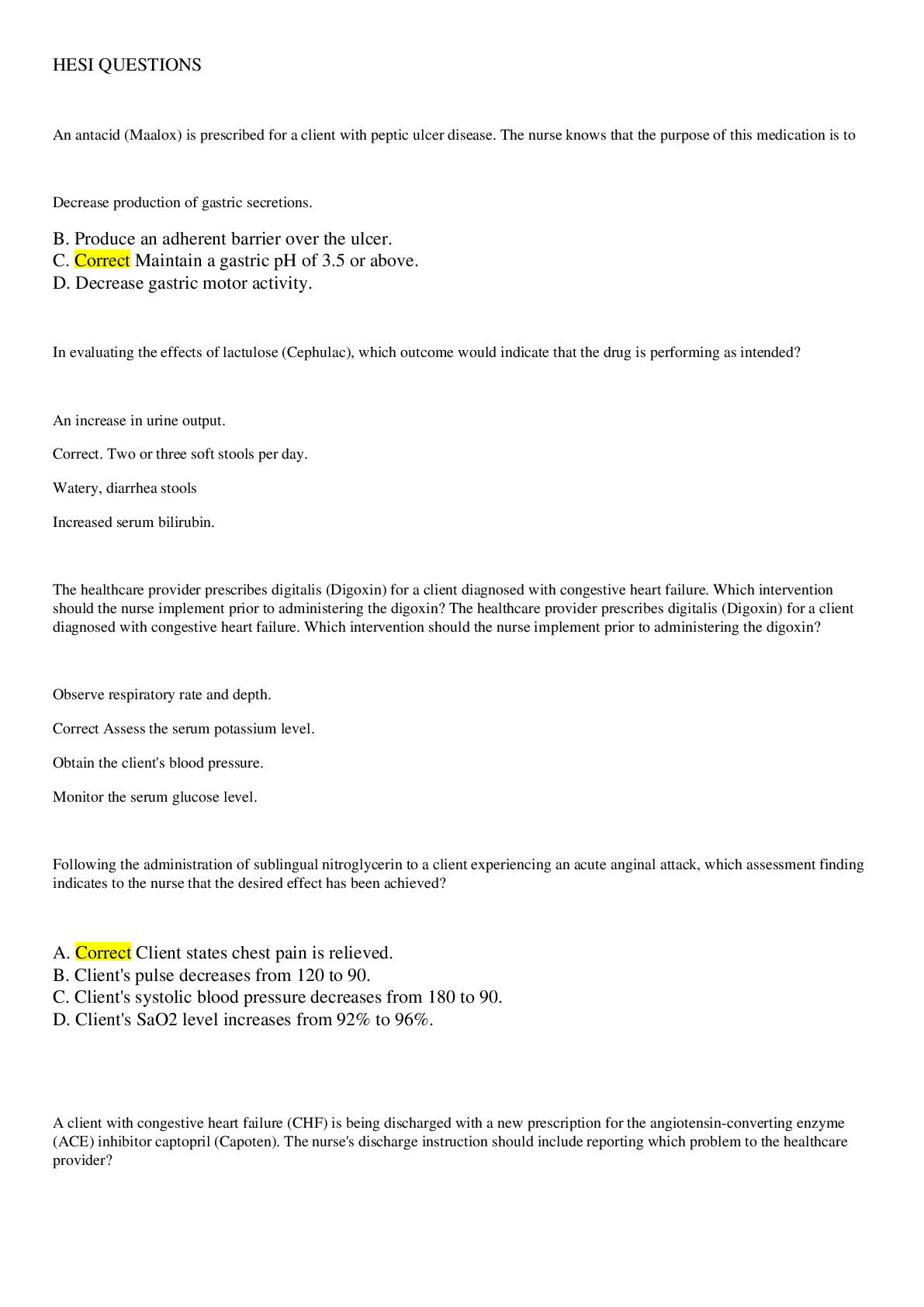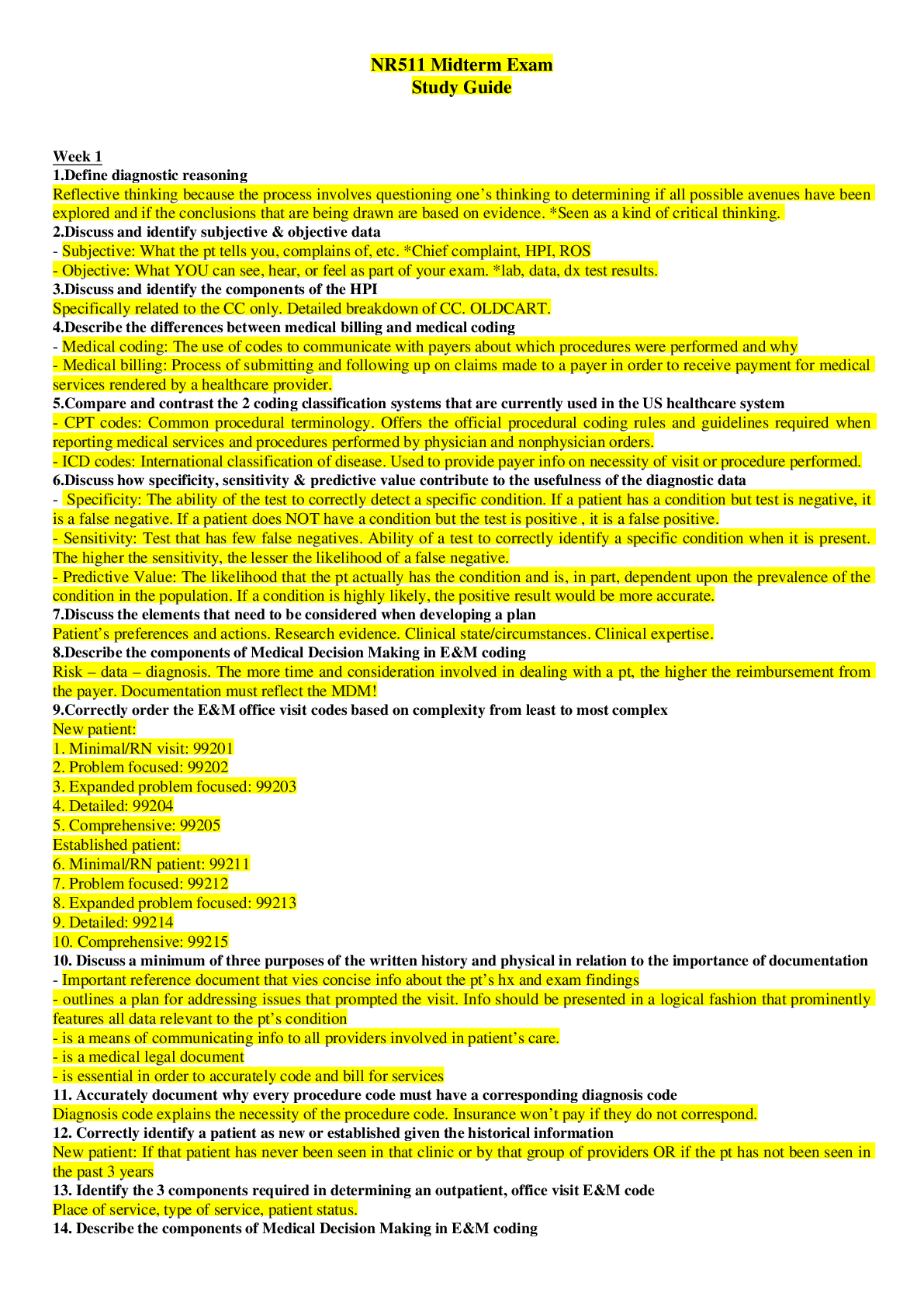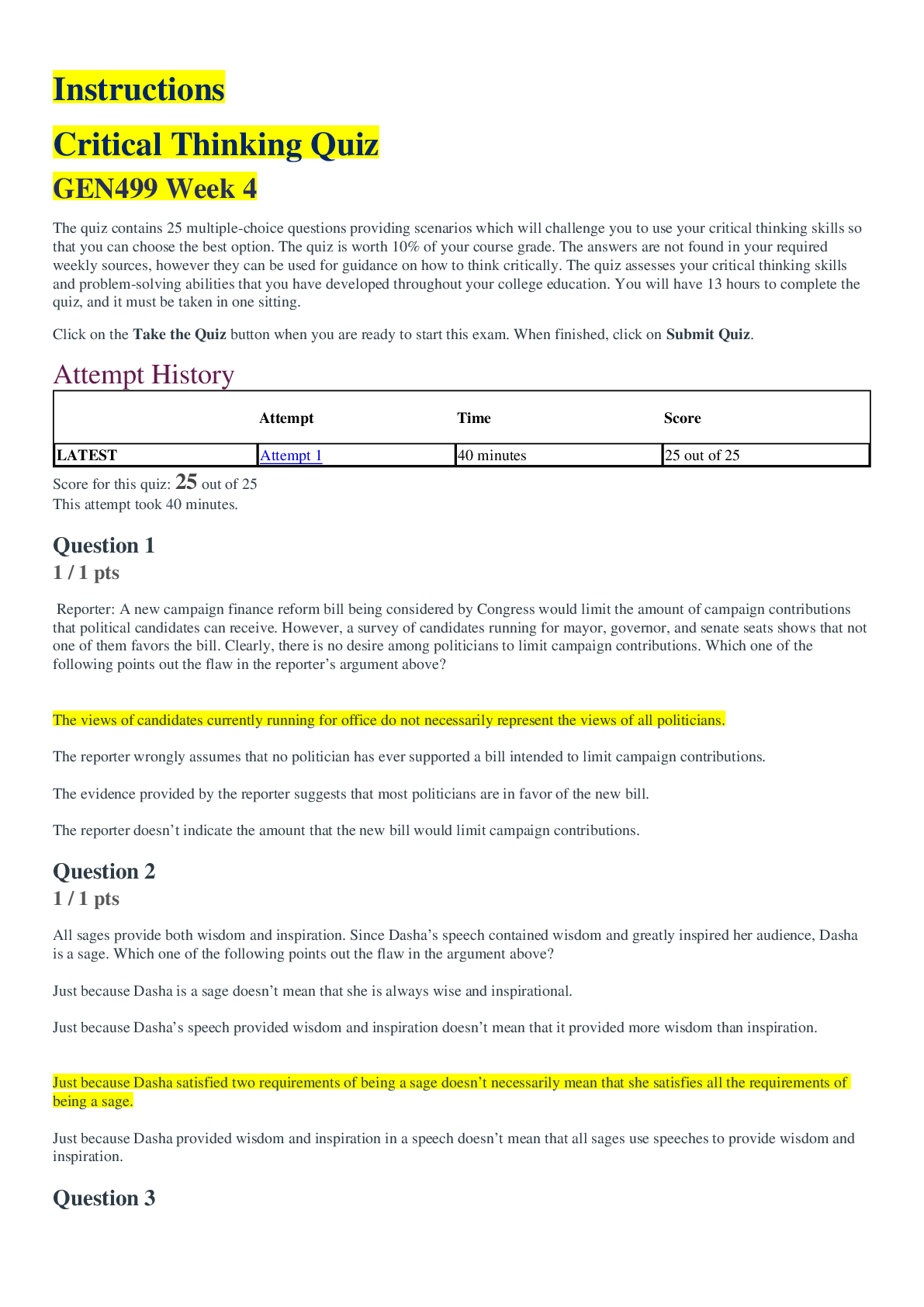Critical care exam 5.docx( Download to score an A+)
Document Content and Description Below
Critical care exam 5.docx A nurse is providing teaching for a client scheduled for a gastrectomy. Which of the following information regarding prevention of postoperative complications should the n... urse include in the teaching? A nurse is teaching a client who has a prescription of a NG tube to treat a pyloric obstruction. Which of the following rationales for the use of the NG tube should the nurse include in the teaching? A nurse is caring for a client who just had an upper gastrointestinal endoscopic procedure. Which of the following is the assessment priority for the client? A nurse is preparing a client for abdominal paracentesis. Which of the following positions should the nurse assist the client into for this procedure? A client is admitted to the hospital reports recurrent flank pain, nausea, and vomiting for 24 hr. Which of the following would be a priority nursing action? A nurse is completing discharge instructions with a client following hospitalization for an acute gout onset. Which of the following client statements should indicate to the nurse that the client understands the treatment regimen? A nurse is teaching a client who has hepatitis A about preventing the transmission of the virus. The nurse should include which of the following strategies? A nurse is caring for a client admitted for an acute exacerbation of ulcerative colitis. The most important nursing goal for this client is to? A nurse is creating a plan of care for a client who had advanced cirrhosis. Which of the following manifestation should the nurse expect to find? A client comes to the emergency department reporting nausea and vomiting that worsens when he lies down. Antacids do not help. The provider suspects pancreatitis. Which of the following laboratory test results should the nurse expect to see if the client has acute pancreatitis? A nurse is caring for a client who has hepatitis B and a long history of IV drug use. Which of the following interventions is important for the nurse to include in the clients plan of care? A nurse is implementing a plan of care for a client who has Hepatitis B. Which of the following should the nurse implement? A nurse has administered an intramuscular injection to a patient with hepatitis C. Before placing in a puncture-resistant container, which of the following nursing actions display the safety precaution? Hepatitis C- standard precaution Who is at risk for contracting hepatitis C- multiple tattoos on arm A nurse is caring for a client who has cirrhosis and has a prescription for bumetanide. When delivering the clients lunch tray. Which of the following items should the nurse identify as contraindicated for the client? a. Ham sandwich A nurse is planning care for a client who has end-stage cirrhosis of the liver with encephalopathy. Which of the following interventions should the nurse plan to implement to decrease the client’s ammonia level? a. Reduce the client’s intake of protein A nurse is planning care for a client who has viral hepatitis. Which of the following actions should the nurse include in the plan of care? a. Provide a high carbohydrate diet A nurse is assessing a client who has cirrhosis. Which of the following is an expected finding for this client? a. Spider angiomas A nurse is caring for a client who has acute pancreatitis. After treating the clients pain, which of the following should the nurse address as the priority intervention? a. Withhold oral fluids and food GERD- lie on right side when sleeping GERD- sleep with HOB elevated Acute pancreatitis elevation- Amylase A nurse is admitting a client who has acute pancreatitis. Which of the following provider prescriptions should the nurse anticipate? a. Pantoprazole 80 mg IV bolus twice daily A nurse is teaching a class about preventative care to clients who are at risk for acquiring viral hepatitis. Which of the following information should the nurse include in the presentation? a. Avoid foods prepared with tap water A nurse is planning care for a client who has cirrhosis of the liver. Which of the following actions should the nurse include in the plan of care? (select all) a. Administer furosemide b. Implement a low-sodium diet c. Measure the clients abdominal girth A nurse is caring for a client with hepatitis A. The client asks the nurse how he might have contracted the virus. Which of the following is a question the nurse should ask the client? a. Have you been to a third world country in the past? Jaundice in African-Americans – hard palate A nurse is teaching a client about causes of biliary cirrhosis. Which of the following information should the nurse include in the teaching? a. Obstruction of the bile duct A nurse is interviewing a client who has acute pancreatitis. Which of the following factors should the nurse anticipate finding the clients history? a. Gallstones A nurse is caring for a client who has liver cirrhosis with ascites, bleeding esophageal varicies, and portal hypertension. The nurse recognizes which of the following laboratory findings as indicating the clients GI tract is digesting and absorbing blood? a. Elevated BUN Patient with IBS- increase fiber intake to at least 30 g per day Peptic ulcer- board like abdomen Hep C antibodies- enzyme immunoassay (EIA) Pancreatitis patients will have a decreased- calcium level and increased amylase Patient with cirrhosis should avoid straining while pooping Cirrhosis- elevated bilirubin –limit protein to reduce ammonia level A nurse is caring for a client who has bleeding esophageal varicies treated with a Sengstaken- Blakemore tube. Which of the following nursing actions is appropriate for the nurse to perform? a. Maintain constant observation while the balloons are inflated A nurse is talking with a client who has cholelithiasis and is about to have an oral cholangiogram. Which of the following client statements indicates to the nurse that he understands the purpose of the procedure? a. They are going to examine my gallbladder ducts A nurse is responding to a client who has esophageal varices from portal hypertension. The client has IV fluids infusing and has a blood pressure of 68/48 after vomiting up 500 ml of blood. Which of the following actions should the nurse do first? a. Increase IV fluid rate A nurse is caring for a client who has a suspected cholecystitis. Which of the following should the nurse find when assessing the clients urine? a. Yellow-orange Esophageal varicies- provide oral and nares care every 2 hours Cholelithiasis expected finding- fatty stools Deficient vitamin K in cirrhosis- petechie and purpura Cirrhosis- decreased sodium, increased bleeding time Cirhrhosis- edema, pruritis, bleeding Cirhosis with ascites- caused by portal hypotension Chapter 38: Assessment of Gastrointestinal System Lewis: Medical-Surgical Nursing, 10th Edition MULTIPLE CHOICE 1. Which information about an 80-yr-old male patient at the senior center is of most concern to the nurse? a. Decreased appetite c. Difficulty chewing food b. Unintended weight loss d. Complaints of indigestion ANS: B Unintentional weight loss is not a normal finding and may indicate a problem such as cancer or depression. Poor appetite, difficulty in chewing, and complaints of indigestion are common in older patients. These will need to be addressed but are not of as much concern as the weight loss. DIF: Cognitive Level: Analyze (analysis) REF: 839 OBJ: Special Questions: Prioritization TOP: Nursing Process: Assessment MSC: NCLEX: Physiological Integrity 2. An older patient reports chronic constipation. To promote bowel evacuation, the nurse will suggest that the patient attempt defecation a. in the mid-afternoon. b. after eating breakfast. c. right after getting up in the morning. d. immediately before the first daily meal. ANS: B The gastrocolic reflex is most active after the first daily meal. Arising in the morning, the anticipation of eating, and physical exercise do not stimulate these reflexes. DIF: Cognitive Level: Apply (application) REF: 836 TOP: Nursing Process: Implementation MSC: NCLEX: Physiological Integrity 3. When caring for a patient with a history of a total gastrectomy, the nurse will monitor for a. constipation. b. dehydration. c. elevated total serum cholesterol. d. cobalamin (vitamin B12) deficiency. ANS: D The patient with a total gastrectomy does not secrete intrinsic factor, which is needed for cobalamin (vitamin B12) absorption. Because the stomach absorbs only small amounts of water and nutrients, the patient is not at higher risk for dehydration, elevated cholesterol, or constipation. DIF: Cognitive Level: Apply (application) REF: 835 TOP: Nursing Process: Assessment MSC: NCLEX: Physiological Integrity 4. The nurse will plan to monitor a patient with an obstructed common bile duct for a. melena. b. steatorrhea. c. decreased serum cholesterol level. d. increased serum indirect bilirubin level. ANS: B A common bile duct obstruction will reduce the absorption of fat in the small intestine, leading to fatty stools. Gastrointestinal bleeding is not caused by common bile duct obstruction. Serum cholesterol levels are increased with biliary obstruction. Direct bilirubin level is increased with biliary obstruction. DIF: Cognitive Level: Apply (application) REF: 847 TOP: Nursing Process: Planning MSC: NCLEX: Physiological Integrity 5. The nurse receives the following information about a 51-yr-old female patient who is scheduled for a colonoscopy. Which information should be communicated to the health care provider before sending the patient for the procedure? a. The patient has a permanent pacemaker to prevent bradycardia. b. The patient is worried about discomfort during the examination. c. The patient has had an allergic reaction to both shellfish and iodine in the past. d. The patient declined to drink the prescribed polyethylene glycol (GoLYTELY). ANS: D If the patient has had inadequate bowel preparation, the colon cannot be visualized and the procedure should be rescheduled. Because contrast solution is not used during colonoscopy, the iodine allergy is not pertinent. A pacemaker is a contraindication to magnetic resonance imaging but not to colonoscopy. The nurse should instruct the patient about the sedation used during the examination to decrease the patient’s anxiety about discomfort. DIF: Cognitive Level: Apply (application) REF: 849 TOP: Nursing Process: Assessment MSC: NCLEX: Health Promotion and Maintenance 6. Which statement to the nurse from a patient with jaundice indicates a need for teaching? a. “I used cough syrup several times a day last week.” b. “I take a baby aspirin every day to prevent strokes.” c. “I use acetaminophen (Tylenol) every 4 hours for back pain.” d. “I need to take an antacid for indigestion several times a week” ANS: C Chronic use of high doses of acetaminophen can be hepatotoxic and may have caused the patient’s jaundice. The other patient statements require further assessment by the nurse but do not indicate a need for patient education. DIF: Cognitive Level: Apply (application) REF: 840 TOP: Nursing Process: Assessment MSC: NCLEX: Physiological Integrity 7. To palpate the liver during a head-to-toe physical assessment, the nurse a. places one hand on the patient’s back and presses upward and inward with the other hand below the patient’s right costal margin. b. places one hand on top of the other and uses the upper fingers to apply pressure and the bottom fingers to feel for the liver edge. c. presses slowly and firmly over the right costal margin with one hand and withdraws the fingers quickly after the liver edge is felt. d. places one hand under the patient’s lower ribs and presses the left lower rib cage forward, palpating below the costal margin with the other hand. ANS: A The liver is normally not palpable below the costal margin. The nurse needs to push inward below the right costal margin while lifting the patient’s back slightly with the left hand. The other methods will not allow palpation of the liver. DIF: Cognitive Level: Apply (application) REF: 844 TOP: Nursing Process: Assessment MSC: NCLEX: Health Promotion and Maintenance 8. Which finding by the nurse during abdominal auscultation indicates a need for a focused abdominal assessment? a. Loud gurgles c. Absent bowel sounds b. High-pitched gurgles d. Frequent clicking sounds ANS: C Absent bowel sounds are abnormal and require further assessment by the nurse. The other sounds may be heard normally. DIF: Cognitive Level: Apply (application) REF: 844 TOP: Nursing Process: Assessment MSC: NCLEX: Physiological Integrity 9. After assisting with a needle biopsy of the liver at a patient’s bedside, the nurse should a. put pressure on the biopsy site using a sandbag. b. elevate the head of the bed to facilitate breathing. c. place the patient on the right side with the bed flat. d. check the patient’s postbiopsy coagulation studies. ANS: C After a biopsy, the patient lies on the right side with the bed flat to splint the biopsy site. Coagulation studies are checked before the biopsy. A sandbag does not exert adequate pressure to splint the site. DIF: Cognitive Level: Apply (application) REF: 850 TOP: Nursing Process: Implementation MSC: NCLEX: Physiological Integrity 10. A 42-yr-old patient is admitted to the outpatient testing area for an ultrasound of the gallbladder. Which information obtained by the nurse indicates that the ultrasound may need to be rescheduled? a. The patient took a laxative the previous evening. b. The patient had a high-fat meal the previous evening. c. The patient has a permanent gastrostomy tube in place. d. The patient ate a low-fat bagel 4 hours ago for breakfast. ANS: D Food intake can cause the gallbladder to contract and result in a suboptimal study. The patient should be NPO for 8 to 12 hours before the test. A high-fat meal the previous evening, laxative use, or a gastrostomy tube will not affect the results of the study. DIF: Cognitive Level: Apply (application) REF: 848 TOP: Nursing Process: Implementation MSC: NCLEX: Physiological Integrity 11. The nurse is assessing an alert and independent 78-yr-old patient for malnutrition risk. Which is the most appropriate initial question? a. “How do you get to the store to buy your food?” b. “Can you tell me the food that you ate yesterday?” c. “Do you have any difficulty in preparing or eating food?” d. “Are you taking any medications that alter your taste for food?” ANS: B This question is the most open-ended and will provide the best overall information about the patient’s daily intake and risk for poor nutrition. The other questions may be asked, depending on the patient’s response to the first question. DIF: Cognitive Level: Analyze (analysis) REF: 841 TOP: Nursing Process: Assessment MSC: NCLEX: Health Promotion and Maintenance 12. A patient has just arrived in the recovery area after an upper endoscopy. Which information collected by the nurse is most important to communicate to the health care provider? a. The patient is very drowsy. b. The patient reports a sore throat. c. The oral temperature is 101.4°F. d. The apical pulse is 100 beats/minute. ANS: C A temperature elevation may indicate that an acute perforation has occurred. The other assessment data are normal immediately after the procedure. DIF: Cognitive Level: Analyze (analysis) REF: 850 OBJ: Special Questions: Prioritization TOP: Nursing Process: Assessment MSC: NCLEX: Physiological Integrity 13. A 30-yr-old male patient with a body mass index (BMI) of 22 kg/m2 is being admitted to the hospital for elective knee surgery. Which assessment finding is important to report to the health care provider? a. Tympany on percussion of the abdomen b. Liver edge 3 cm below the costal margin c. Bowel sounds of 20/minute in each quadrant d. Aortic pulsations visible in the epigastric area ANS: B Normally the lower border of the liver is not palpable below the ribs, so this finding suggests hepatomegaly. The other findings are within normal range for the physical assessment. DIF: Cognitive Level: Apply (application) REF: 847 OBJ: Special Questions: Prioritization TOP: Nursing Process: Assessment MSC: NCLEX: Physiological Integrity 14. A 58-yr-old patient has just returned to the nursing unit after an esophagogastroduodenoscopy (EGD). Which action by unlicensed assistive personnel (UAP) requires that the registered nurse (RN) intervene? a. Offering the patient a pitcher of water b. Positioning the patient on the right side c. Checking the vital signs every 30 minutes d. Swabbing the patient’s mouth with a wet cloth ANS: A Immediately after EGD, the patient will have a decreased gag reflex and is at risk for aspiration. Assessment for return of the gag reflex should be done by the RN. The other actions by the UAP are appropriate. DIF: Cognitive Level: Apply (application) REF: 849 OBJ: Special Questions: Delegation TOP: Nursing Process: Implementation MSC: NCLEX: Safe and Effective Care Environment 15. A patient is being scheduled for endoscopic retrograde cholangiopancreatography (ERCP) as soon as possible. Which prescribed action should the nurse take first? a. Place the patient on NPO status. b. Administer sedative medications. c. Ensure the consent form is signed. d. Teach the patient about the procedure. ANS: A The patient will need to be NPO for 8 hours before the ERCP is done, so the nurse’s initial action should be to place the patient on NPO status. The other actions can be done after the patient is NPO. DIF: Cognitive Level: Analyze (analysis) REF: 850 OBJ: Special Questions: Prioritization TOP: Nursing Process: Implementation MSC: NCLEX: Physiological Integrity 16. While interviewing a young adult patient, the nurse learns that the patient has a family history of familial adenomatous polyposis (FAP). The nurse will plan to assess the patient’s knowledge about a. preventing noninfectious hepatitis. b. treating inflammatory bowel disease. c. risk for developing colorectal cancer. d. using antacids and proton pump inhibitors. ANS: C FAP is a genetic condition that greatly increases the risk for colorectal cancer. Noninfectious hepatitis, use of medications that treat increased gastric pH, and inflammatory bowel disease are not related to FAP. DIF: Cognitive Level: Apply (application) REF: 841 TOP: Nursing Process: Planning MSC: NCLEX: Health Promotion and Maintenance 17. Which area of the abdomen shown in the accompanying figure will the nurse palpate to assess for splenomegaly? a. 1 b. 2 c. 3 d. 4 ANS: B The spleen is usually not palpable, but when palpated, it is located in left upper quadrant of abdomen. DIF: Cognitive Level: Understand (comprehension) REF: 875 TOP: Nursing Process: Assessment MSC: NCLEX: Health Promotion and Maintenance Chapter 43: Liver, Pancreas, and Biliary Tract Problems Lewis: Medical-Surgical Nursing, 10th Edition MULTIPLE CHOICE 1. A young adult contracts hepatitis from contaminated food. During the acute (icteric) phase of the patient’s illness, the nurse would expect serologic testing to reveal a. antibody to hepatitis D (anti-HDV). b. hepatitis B surface antigen (HBsAg). c. anti-hepatitis A virus immunoglobulin G (anti-HAV IgG). d. anti-hepatitis A virus immunoglobulin M (anti-HAV IgM). ANS: D Hepatitis A is transmitted through the oral-fecal route, and antibody to HAV IgM appears during the acute phase of hepatitis A. The patient would not have antigen for hepatitis B or antibody for hepatitis D. Anti-HAV IgG would indicate past infection and lifelong immunity. DIF: Cognitive Level: Apply (application) REF: 980 TOP: Nursing Process: Assessment MSC: NCLEX: Physiological Integrity 2. The nurse evaluates that administration of hepatitis B vaccine to a healthy patient has been effective when the patient’s blood specimen reveals a. HBsAg. c. anti-HBc IgG. b. anti-HBs. d. anti-HBc IgM. ANS: B The presence of surface antibody to HBV (anti-HBs) is a marker of a positive response to the vaccine. The other laboratory values indicate current infection with HBV. DIF: Cognitive Level: Apply (application) REF: 980 TOP: Nursing Process: Evaluation MSC: NCLEX: Health Promotion and Maintenance 3. A patient in the outpatient clinic is diagnosed with acute hepatitis C (HCV) infection. Which action by the nurse is appropriate? a. Schedule the patient for HCV genotype testing. b. Administer the HCV vaccine and immune globulin. c. Teach the patient about ribavirin (Rebetol) treatment. d. Explain that the infection will resolve over a few months. ANS: A Genotyping of HCV has an important role in managing treatment and is done before drug therapy is initiated. Because most patients with acute HCV infection convert to the chronic state, the nurse should not teach the patient that the HCV will resolve in a few months. Immune globulin or vaccine is not available for HCV. Ribavirin is used for chronic HCV infection. DIF: Cognitive Level: Apply (application) REF: 980 TOP: Nursing Process: Implementation MSC: NCLEX: Physiological Integrity 4. The nurse will plan to teach the patient diagnosed with acute hepatitis B about a. administering -interferon b. side effects of nucleotide analogs. c. measures for improving the appetite. d. ways to increase activity and exercise. ANS: C Maintaining adequate nutritional intake is important for regeneration of hepatocytes. Interferon and antivirals may be used for chronic hepatitis B, but they are not prescribed for acute hepatitis B infection. Rest is recommended. DIF: Cognitive Level: Apply (application) REF: 980 TOP: Nursing Process: Planning MSC: NCLEX: Physiological Integrity 5. The nurse administering -interferon and ribavirin (Rebetol) to a patient with chronic hepatitis C will plan to monitor for a. leukopenia. c. polycythemia. b. hypokalemia. d. hypoglycemia. ANS: A Therapy with ribavirin and -interferon may cause leukopenia. The other problems are not associated with this drug therapy. DIF: Cognitive Level: Apply (application) REF: 981 TOP: Nursing Process: Planning MSC: NCLEX: Physiological Integrity 6. Which information given by a 70-yr-old patient during a health history indicates to the nurse that the patient should be screened for hepatitis C? a. The patient had a blood transfusion in 2005. b. The patient used IV drugs about 20 years ago. c. The patient frequently eats in fast-food restaurants. d. The patient traveled to a country with poor sanitation. ANS: B Any patient with a history of IV drug use should be tested for hepatitis C. Blood transfusions given after 1992 (when an antibody test for hepatitis C became available) do not pose a risk for hepatitis C. Hepatitis C is not spread by the oral- fecal route and therefore is not caused by contaminated food or by traveling in underdeveloped countries. DIF: Cognitive Level: Apply (application) REF: 976 TOP: Nursing Process: Assessment MSC: NCLEX: Health Promotion and Maintenance 7. A patient admitted with an abrupt onset of jaundice and nausea has abnormal liver function studies but serologic testing is negative for viral causes of hepatitis. Which question by the nurse is appropriate? a. “Do you have a history of IV drug use?” b. “Do you use any over-the-counter drugs?” c. “Have you used corticosteroids for any reason?” d. “Have you recently traveled to a foreign country?” ANS: B The patient’s symptoms, lack of antibodies for hepatitis, and the abrupt onset of symptoms suggest toxic hepatitis, which can be caused by commonly used over- the-counter drugs such as acetaminophen (Tylenol). Travel to a foreign country and a history of IV drug use are risk factors for viral hepatitis. Corticosteroid use does not cause the symptoms listed. DIF: Cognitive Level: Apply (application) REF: 984 TOP: Nursing Process: Assessment MSC: NCLEX: Physiological Integrity 8. Which focused data will the nurse monitor in relation to the 4+ pitting edema assessed in a patient with cirrhosis? a. Hemoglobin c. Activity level b. Temperature d. Albumin level ANS: D The low oncotic pressure caused by hypoalbuminemia is a major pathophysiologic factor in the development of edema. The other parameters are not directly associated with the patient’s edema. DIF: Cognitive Level: Apply (application) REF: 988 TOP: Nursing Process: Assessment MSC: NCLEX: Physiological Integrity 9. Which topic is most important to include in patient teaching for a 41- yr-old patient diagnosed with early alcoholic cirrhosis? a. Taking lactulose c. Avoiding alcohol ingestion b. Maintaining good nutrition d. Using vitamin B supplements ANS: C The disease progression can be stopped or reversed by alcohol abstinence. The other interventions may be used when cirrhosis becomes more severe to decrease symptoms or complications, but the priority for this patient is to stop the progression of the disease. DIF: Cognitive Level: Analyze (analysis) REF: 995 TOP: Nursing Process: Planning MSC: NCLEX: Physiological Integrity 10. A serum potassium level of 3.2 mEq/L (3.2 mmol/L) is reported for a patient with cirrhosis who has scheduled doses of spironolactone (Aldactone) and furosemide (Lasix) due. Which action should the nurse take? a. Withhold both drugs. c. Administer the furosemide. b. Administer both drugs d. Administer the spironolactone. ANS: D Spironolactone is a potassium-sparing diuretic and will help increase the patient’s potassium level. The nurse does not need to talk with the doctor before giving the spironolactone, although the health care provider should be notified about the low potassium value. The furosemide will further decrease the patient’s potassium level and should be held until the nurse talks with the health care provider. DIF: Cognitive Level: Apply (application) REF: 991 TOP: Nursing Process: Implementation MSC: NCLEX: Physiological Integrity 11. Which action should the nurse take to evaluate treatment effectiveness for a patient who has hepatic encephalopathy? a. Request that the patient stand on one foot. b. Ask the patient to extend both arms forward. c. Request that the patient walk with eyes closed. d. Ask the patient to perform the Valsalva maneuver. ANS: B Extending the arms allows the nurse to check for asterixis, a classic sign of hepatic encephalopathy. The other tests might also be done as part of the neurologic assessment but would not be diagnostic for hepatic encephalopathy. DIF: Cognitive Level: Apply (application) REF: 990 TOP: Nursing Process: Assessment MSC: NCLEX: Physiological Integrity 12. Which finding indicates to the nurse that lactulose is effective for an older adult who has advanced cirrhosis? a. The patient is alert and oriented. b. The patient denies nausea or anorexia. c. The patient’s bilirubin level decreases. d. The patient has at least one stool daily. ANS: A The purpose of lactulose in the patient with cirrhosis is to lower ammonia levels and prevent encephalopathy. Although lactulose may be used to treat constipation, that is not the purpose for this patient. Lactulose will not decrease nausea and vomiting or lower bilirubin levels. DIF: Cognitive Level: Apply (application) REF: 992 TOP: Nursing Process: Evaluation MSC: NCLEX: Physiological Integrity 13. A patient is being treated for bleeding esophageal varices with balloon tamponade. Which nursing action will be included in the plan of care? a. Instruct the patient to cough every hour. b. Monitor the patient for shortness of breath. c. Verify the position of the balloon every 4 hours. d. Deflate the gastric balloon if the patient reports nausea. ANS: B The most common complication of balloon tamponade is aspiration pneumonia. In addition, if the gastric balloon ruptures, the esophageal balloon may slip upward and occlude the airway. Coughing increases the pressure on the varices and increases the risk for bleeding. Balloon position is verified after insertion and does not require further verification. Balloons may be deflated briefly every 8 to 12 hours to avoid tissue necrosis, but if only the gastric balloon is deflated, the esophageal balloon may occlude the airway. Balloons are not deflated for nausea. DIF: Cognitive Level: Apply (application) REF: 992 TOP: Nursing Process: Implementation MSC: NCLEX: Physiological Integrity 14. To detect possible complications in a patient with severe cirrhosis who has bleeding esophageal varices, it is most important for the nurse to monitor a. bilirubin levels. c. potassium levels. b. ammonia levels. d. prothrombin time. ANS: B The protein in the blood in the gastrointestinal tract will be absorbed and may result in an increase in the ammonia level because the liver cannot metabolize protein very well. The prothrombin time, bilirubin, and potassium levels should also be monitored, but they will not be affected by the bleeding episode. DIF: Cognitive Level: Analyze (analysis) REF: 990 TOP: Nursing Process: Assessment MSC: NCLEX: Physiological Integrity 15. A patient with cirrhosis has ascites and 4+ edema of the feet and legs. Which nursing action will be included in the plan of care? a. Restrict daily dietary protein intake. b. Reposition the patient every 4 hours. c. Perform passive range of motion twice daily. d. Place the patient on a pressure-relief mattress. ANS: D The pressure-relieving mattress will decrease the risk for skin breakdown for this patient. Adequate dietary protein intake is necessary in patients with ascites to improve oncotic pressure. Repositioning the patient every 4 hours will not be adequate to maintain skin integrity. Passive range of motion will not take the pressure off areas such as the sacrum that are vulnerable to breakdown. DIF: Cognitive Level: Apply (application) REF: 994 TOP: Nursing Process: Implementation MSC: NCLEX: Physiological Integrity 16. Which finding indicates to the nurse that a patient’s transjugular intrahepatic portosystemic shunt (TIPS) placed 3 months ago has been effective? a. Increased serum albumin level b. Decreased indirect bilirubin level c. Improved alertness and orientation d. Fewer episodes of bleeding varices ANS: D TIPS is used to lower pressure in the portal venous system and decrease the risk of bleeding from esophageal varices. Indirect bilirubin level and serum albumin levels are not affected by shunting procedures. TIPS will increase the risk for hepatic encephalopathy. DIF: Cognitive Level: Apply (application) REF: 992 TOP: Nursing Process: Evaluation MSC: NCLEX: Physiological Integrity 17. To prepare a patient with ascites for paracentesis, the nurse a. places the patient on NPO status. b. assists the patient to lie flat in bed. c. asks the patient to empty the bladder. d. positions the patient on the right side. ANS: C The patient should empty the bladder to decrease the risk of bladder perforation during the procedure. The patient would be positioned in Fowler’s position and would not be able to lie flat without compromising breathing. Because no sedation is required for paracentesis, the patient does not need to be NPO. DIF: Cognitive Level: Apply (application) REF: 994 TOP: Nursing Process: Implementation MSC: NCLEX: Physiological Integrity 18. Which finding is most important for the nurse to communicate to the health care provider about a patient who received a liver transplant 1 week ago? a. Dry palpebral and oral mucosa c. Temperature 100.8° F (38.2° C) b. Crackles at bilateral lung bases d. No bowel movement for 4 days ANS: C The risk of infection is high in the first few months after liver transplant, and fever is frequently the only sign of infection. The other patient data indicate the need for further assessment or nursing actions and might be communicated to the health care provider, but they do not indicate a need for urgent action. DIF: Cognitive Level: Analyze (analysis) REF: 998 OBJ: Special Questions: Prioritization TOP: Nursing Process: Implementation MSC: NCLEX: Physiological Integrity 19. Which laboratory test result will the nurse monitor when evaluating the effects of therapy for a patient who has acute pancreatitis? a. Calcium c. Amylase b. Bilirubin d. Potassium ANS: C Amylase is elevated in acute pancreatitis. Although changes in the other values may occur, they would not be useful in evaluating whether the prescribed therapies have been effective. DIF: Cognitive Level: Apply (application) REF: 1000 TOP: Nursing Process: Evaluation MSC: NCLEX: Physiological Integrity 20. Which assessment finding would the nurse need to report most quickly to the health care provider regarding a patient with acute pancreatitis? a. Nausea and vomiting b. Hypotonic bowel sounds c. Muscle twitching and finger numbness d. Upper abdominal tenderness and guarding ANS: C Muscle twitching and finger numbness indicate hypocalcemia, which may lead to tetany unless calcium gluconate is administered. Although the other findings should also be reported to the health care provider, they do not indicate complications that require rapid action. DIF: Cognitive Level: Analyze (analysis) REF: 1002 OBJ: Special Questions: Prioritization TOP: Nursing Process: Assessment MSC: NCLEX: Physiological Integrity 21. The nurse will ask a patient being admitted with acute pancreatitis specifically about a history of a. diabetes mellitus. c. cigarette smoking. b. high-protein diet. d. alcohol consumption. ANS: D Alcohol use is one of the most common risk factors for pancreatitis in the United States. Cigarette smoking, diabetes, and high-protein diets are not risk factors. DIF: Cognitive Level: Understand (comprehension) REF: 1003 TOP: Nursing Process: Assessment MSC: NCLEX: Physiological Integrity 22. The nurse will teach a patient with chronic pancreatitis to take the prescribed pancrelipase (Viokase) a. at bedtime. c. in the morning. b. with meals. d. for abdominal pain. ANS: B Pancreatic enzymes are used to help with digestion of nutrients and should be taken with every meal. DIF: Cognitive Level: Apply (application) REF: 1004 TOP: Nursing Process: Implementation MSC: NCLEX: Physiological Integrity 23. The nurse recognizes that teaching a patient following a laparoscopic cholecystectomy has been effective when the patient makes which statement? a. “I can expect yellow-green drainage from the incision for a few days.” b. “I can remove the bandages on my incisions tomorrow and take a shower.” c. “I should plan to limit my activities and not return to work for 4 to 6 weeks.” d. “I will need to maintain a low-fat diet for life because I no longer have a gallbladder.” ANS: B After a laparoscopic cholecystectomy, the patient will have Band-Aids in place over the incisions. Patients are discharged the same (or next) day and have few restrictions on activities of daily living. Drainage from the incisions would be abnormal, and the patient should be instructed to call the health care provider if this occurs. A low-fat diet may be recommended for a few weeks after surgery but will not be a lifelong requirement. DIF: Cognitive Level: Apply (application) REF: 1010 TOP: Nursing Process: Evaluation MSC: NCLEX: Physiological Integrity 24. The nurse is caring for a patient who has cirrhosis. Which data obtained by the nurse during the assessment will be of most concern? a. The patient complains of right upper-quadrant pain with palpation. b. The patient’s hands flap back and forth when the arms are extended. c. The patient has ascites and a 2-kg weight gain from the previous day. d. The patient’s abdominal skin has multiple spider-shaped blood vessels. ANS: B Asterixis indicates that the patient has hepatic encephalopathy, and hepatic coma may occur. The spider angiomas and right upper quadrant abdominal pain are not unusual for the patient with cirrhosis and do not require a change in treatment. The ascites and weight gain indicate the need for treatment but not as urgently as the changes in neurologic status. DIF: Cognitive Level: Analyze (analysis) REF: 990 OBJ: Special Questions: Prioritization TOP: Nursing Process: Assessment MSC: NCLEX: Physiological Integrity 25. A patient with cirrhosis and esophageal varices has a new prescription for propranolol (Inderal). Which finding is the best indicator to the nurse that the medication has been effective? a. The patient reports no chest pain. b. Blood pressure is 140/90 mm Hg. c. Stools test negative for occult blood. d. The apical pulse rate is 68 beats/minute. ANS: C Because the purpose of -blocker therapy for patients with esophageal varices is to decrease the risk for bleeding from esophageal varices, the best indicator of the effectiveness for propranolol is the lack of blood in the stools. Although propranolol is used to treat hypertension, angina, and tachycardia, the purpose for use in this patient is to decrease the risk for bleeding from esophageal varices. DIF: Cognitive Level: Analyze (analysis) REF: 993 TOP: Nursing Process: Evaluation MSC: NCLEX: Physiological Integrity 26. Which response by the nurse best explains the purpose of ranitidine (Zantac) for a patient admitted with bleeding esophageal varices? a. The medication will reduce the risk for aspiration. b. The medication will inhibit development of gastric ulcers. c. The medication will prevent irritation of the enlarged veins. d. The medication will decrease nausea and improve the appetite. ANS: C Esophageal varices are dilated submucosal veins. The therapeutic action of H2- receptor blockers in patients with esophageal varices is to prevent irritation and bleeding from the varices caused by reflux of acid gastric contents. Although ranitidine does decrease the risk for peptic ulcers, reduce nausea, and help prevent aspiration pneumonia, these are not the primary purposes for H2-receptor blockade in this patient. DIF: Cognitive Level: Analyze (analysis) REF: 1004 TOP: Nursing Process: Implementation MSC: NCLEX: Physiological Integrity 27. When taking the blood pressure (BP) on the right arm of a patient with severe acute pancreatitis, the nurse notices carpal spasms of the patient’s right hand. Which action should the nurse take next? a. Ask the patient about any arm pain. b. Retake the patient’s blood pressure. c. Check the calcium level in the chart. d. Notify the health care provider immediately. ANS: C The patient with acute pancreatitis is at risk for hypocalcemia, and the assessment data indicate a positive Trousseau’s sign. The health care provider should be notified after the nurse checks the patient’s calcium level. There is no indication that the patient needs to have the BP rechecked or that there is any arm pain. DIF: Cognitive Level: Apply (application) REF: 1002 TOP: Nursing Process: Assessment MSC: NCLEX: Physiological Integrity 28. A patient with acute pancreatitis is NPO and has a nasogastric (NG) tube to suction. Which information obtained by the nurse indicates that these therapies have been effective? a. Bowel sounds are present. c. Electrolyte levels are normal. b. Grey Turner sign resolves. d. Abdominal pain is decreased. ANS: D NG suction and NPO status will decrease the release of pancreatic enzymes into the pancreas and decrease pain. Although bowel sounds may be hypotonic with acute pancreatitis, the presence of bowel sounds does not indicate that treatment with NG suction and NPO status has been effective. Electrolyte levels may be abnormal with NG suction and must be replaced by appropriate IV infusion. Although Grey Turner sign will eventually resolve, it would not be appropriate to wait for this to occur to determine whether treatment was effective. DIF: Cognitive Level: Apply (application) REF: 1001 TOP: Nursing Process: Evaluation MSC: NCLEX: Physiological Integrity 29. Which assessment finding is of most concern for a patient with acute pancreatitis? a. Absent bowel sounds c. Left upper quadrant pain b. Abdominal tenderness d. Palpable abdominal mass ANS: D A palpable abdominal mass may indicate the presence of a pancreatic abscess, which will require rapid surgical drainage to prevent sepsis. Absent bowel sounds, abdominal tenderness, and left upper quadrant pain are common in acute pancreatitis and do not require rapid action to prevent further complications. DIF: Cognitive Level: Analyze (analysis) REF: 1000 OBJ: Special Questions: Prioritization TOP: Nursing Process: Assessment MSC: NCLEX: Physiological Integrity 30. Which action will be included in the care for a patient who has recently been diagnosed with asymptomatic nonalcoholic fatty liver disease (NAFLD)? a. Teach symptoms of variceal bleeding. b. Draw blood for hepatitis serology testing. c. Discuss the need to increase caloric intake. d. Review the patient’s current medication list. ANS: D Some medications can increase the risk for NAFLD, and they should be eliminated. NAFLD is not associated with hepatitis, weight loss is usually indicated, and variceal bleeding would not be a concern in a patient with asymptomatic NAFLD. DIF: Cognitive Level: Apply (application) REF: 985 TOP: Nursing Process: Planning MSC: NCLEX: Physiological Integrity 31. A patient with chronic hepatitis C infection has several medications prescribed. Which medication requires further discussion with the health care provider before administration? a. Ribavirin (Rebetol, Copegus) 600 mg PO bid b. Diphenhydramine 25 mg PO every 4 hours PRN itching c. Pegylated -interferon (PEG-Intron, Pegasys) 1.5 mcg/kg PO daily d. Dimenhydrinate (Dramamine) 50 mg PO every 6 hours PRN nausea ANS: C Pegylated -interferon is administered subcutaneously, not orally. The medications are all appropriate for a patient with chronic hepatitis C infection. DIF: Cognitive Level: Understand (comprehension) REF: 981 TOP: Nursing Process: Implementation MSC: NCLEX: Physiological Integrity 32. During change-of-shift report, the nurse learns about the following four patients. Which patient requires assessment first? a. A 40-yr-old patient with chronic pancreatitis who has gnawing abdominal pain b. A 58-yr-old patient who has compensated cirrhosis and is complaining of anorexia c. A 55-yr-old patient with cirrhosis and ascites who has an oral temperature of 102° F (38.8° C) d. A 36-yr-old patient recovering from a laparoscopic cholecystectomy who has severe shoulder pain ANS: C This patient’s history and fever suggest possible spontaneous bacterial peritonitis, which would require rapid assessment and interventions such as antibiotic therapy. The clinical manifestations for the other patients are consistent with their diagnoses and do not indicate complications are occurring. DIF: Cognitive Level: Analyze (analysis) REF: 989 OBJ: Special Questions: Multiple Patients TOP: Nursing Process: Assessment MSC: NCLEX: Safe and Effective Care Environment 33. Which goal has the highest priority in the plan of care for a 26-yr-old patient who is homeless who was admitted with viral hepatitis who has severe anorexia and fatigue? a. Increase activity level. b. Maintain adequate nutrition. c. Establish a stable environment. d. Identify source of hepatitis exposure. ANS: B The highest priority outcome is to maintain nutrition because adequate nutrition is needed for hepatocyte regeneration. Finding a home for the patient and identifying the source of the infection would be appropriate activities, but they do not have as high a priority as ensuring adequate nutrition. Although the patient’s activity level will be gradually increased, rest is indicated during the acute phase of hepatitis. DIF: Cognitive Level: Analyze (analysis) REF: 980 OBJ: Special Questions: Prioritization TOP: Nursing Process: Planning MSC: NCLEX: Physiological Integrity 34. Which action should the nurse in the emergency department take first for a new patient who is vomiting blood? a. Insert a large-gauge IV catheter. b. Draw blood for coagulation studies. c. Check blood pressure and heart rate. d. Place the patient in the supine position. ANS: C The nurse’s first action should be to determine the patient’s hemodynamic status by assessing vital signs. Drawing blood for coagulation studies and inserting an IV catheter are also appropriate. However, the vital signs may indicate the need for more urgent actions. Because aspiration is a concern for this patient, the nurse will need to assess the patient’s vital signs and neurologic status before placing the patient in a supine position. DIF: Cognitive Level: Analyze (analysis) REF: 1002 OBJ: Special Questions: Prioritization TOP: Nursing Process: Implementation MSC: NCLEX: Physiological Integrity 35. The nurse is planning care for a patient with acute severe pancreatitis. The highest priority patient outcome is a. maintaining normal respiratory function. b. expressing satisfaction with pain control. c. developing no ongoing pancreatic disease. d. having adequate fluid and electrolyte balance. ANS: A Respiratory failure can occur as a complication of acute pancreatitis and maintenance of adequate respiratory function is the priority goal. The other outcomes would also be appropriate for the patient. DIF: Cognitive Level: Analyze (analysis) REF: 1002 OBJ: Special Questions: Prioritization TOP: Nursing Process: Planning MSC: NCLEX: Physiological Integrity 36. The nurse is caring for a patient with pancreatic cancer. Which nursing action is the highest priority? a. Offer psychologic support for depression. b. Offer high-calorie, high-protein dietary choices. c. Administer prescribed opioids to relieve pain as needed. d. Teach about the need to avoid scratching any pruritic areas. ANS: C Effective pain management will be necessary in order for the patient to improve nutrition, be receptive to teaching, or manage anxiety or depression. DIF: Cognitive Level: Analyze (analysis) REF: 1007 OBJ: Special Questions: Prioritization TOP: Nursing Process: Planning MSC: NCLEX: Physiological Integrity 37. Which assessment information will be most important for the nurse to report to the health care provider about a patient with acute cholecystitis? a. The patient’s urine is bright yellow. b. The patient’s stools are tan colored. c. The patient has increased pain after eating. d. The patient complains of chronic heartburn. ANS: B Tan or gray stools indicate biliary obstruction, which requires rapid intervention to resolve. The other data are not unusual for a patient with this diagnosis, although the nurse would also report the other assessment information to the health care provider. DIF: Cognitive Level: Analyze (analysis) REF: 1008 OBJ: Special Questions: Prioritization TOP: Nursing Process: Assessment MSC: NCLEX: Physiological Integrity 38. A patient had an incisional cholecystectomy 6 hours ago. The nurse will place the highest priority on assisting the patient to a. perform leg exercises hourly while awake. b. ambulate the evening of the operative day. c. turn, cough, and deep breathe every 2 hours. d. choose preferred low-fat foods from the menu. ANS: C Postoperative nursing care after a cholecystectomy focuses on prevention of respiratory complications because the surgical incision is high in the abdomen and impairs coughing and deep breathing. The other nursing actions are also important to implement but are not as high a priority as ensuring adequate ventilation. DIF: Cognitive Level: Analyze (analysis) REF: 1009 OBJ: Special Questions: Prioritization TOP: Nursing Process: Planning MSC: NCLEX: Physiological Integrity 39. For a patient with cirrhosis, which nursing action can the registered nurse (RN) delegate to unlicensed assistive personnel (UAP)? a. Assessing the patient for jaundice b. Providing oral hygiene after a meal c. Palpating the abdomen for distention d. Teaching the patient the prescribed diet ANS: B Providing oral hygiene is within the scope of UAP. Assessments and assisting patients to choose therapeutic diets are nursing actions that require higher level nursing education and scope of practice and would be delegated to licensed practical/vocational nurses (LPNs/LVNs) or RNs. DIF: Cognitive Level: Apply (application) REF: 992 OBJ: Special Questions: Delegation TOP: Nursing Process: Planning MSC: NCLEX: Safe and Effective Care Environment 40. Which action will the nurse include in the plan of care for a patient who has been diagnosed with chronic hepatitis B? a. Advise limiting alcohol intake to 1 drink daily. b. Schedule for liver cancer screening every 6 months. c. Initiate administration of the hepatitis C vaccine series. d. Monitor anti-hepatitis B surface antigen (anti-HBs) levels. ANS: B Patients with chronic hepatitis are at higher risk for development of liver cancer and should be screened for liver cancer every 6 to 12 months. Patients with chronic hepatitis are advised to completely avoid alcohol. There is no hepatitis C vaccine. Because anti-HBs is present whenever there has been a past hepatitis B infection or vaccination, there is no need to regularly monitor for this antibody. DIF: Cognitive Level: Apply (application) REF: 984 TOP: Nursing Process: Planning MSC: NCLEX: Physiological Integrity 41. A patient born in 1955 had hepatitis A infection 1 year ago. According to Centers for Disease Control and Prevention (CDC) guidelines, which action should the nurse include in care when the patient is seen for a routine annual physical examination? a. Start the hepatitis B immunization series. b. Teach the patient about hepatitis A immune globulin. c. Ask whether the patient has been screened for hepatitis C. d. Test for anti-hepatitis-A virus immune globulin M (anti-HAV-IgM). ANS: C Current CDC guidelines indicate that all patients who were born between 1945 and 1965 should be screened for hepatitis C because many individuals who are positive have not been diagnosed. Although routine hepatitis B immunization is recommended for infants, children, and adolescents, vaccination for hepatitis B is recommended only for adults at risk for blood-borne infections. Because the patient has already had hepatitis A, immunization and anti-HAV IgM levels will not be needed. DIF: Cognitive Level: Apply (application) REF: 983 TOP: Nursing Process: Planning MSC: NCLEX: Health Promotion and Maintenance 42. A patient has been admitted with acute liver failure. Which assessment data are most important for the nurse to communicate to the health care provider? a. Asterixis and lethargy c. Elevated total bilirubin level b. Jaundiced sclera and skin d. Liver 3 cm below costal margin ANS: A The patient’s findings of asterixis and lethargy are consistent with grade 2 hepatic encephalopathy. Patients with acute liver failure can deteriorate rapidly from grade 1 or 2 to grade 3 or 4 hepatic encephalopathy and need early transfer to a transplant center. The other findings are typical of patients with hepatic failure and would be reported but would not indicate a need for an immediate change in the therapeutic plan. DIF: Cognitive Level: Analyze (analysis) REF: 990 OBJ: Special Questions: Prioritization TOP: Nursing Process: Assessment MSC: NCLEX: Physiological Integrity 43. A 36-yr-old female patient is receiving treatment for chronic hepatitis C with pegylated interferon (PEG-Intron, Pegasys), ribavirin (Rebetol), and telaprevir (Incivek). Which finding is important to communicate to the health care provider to suggest a change in therapy? a. Weight loss of 2 lb (1 kg) b. Positive urine pregnancy test c. Hemoglobin level of 10.4 g/dL d. Complaints of nausea and anorexia ANS: B Because ribavirin is teratogenic, the medication will need to be discontinued immediately. Anemia, weight loss, and nausea are common adverse effects of the prescribed regimen and may require actions such as patient teaching, but they would not require immediate cessation of the therapy. DIF: Cognitive Level: Apply (application) REF: 981 OBJ: Special Questions: Prioritization TOP: Nursing Process: Assessment MSC: NCLEX: Physiological Integrity 44. A nurse is considering which patient to admit to the same room as a patient who had a liver transplant 3 weeks ago and is now hospitalized with acute rejection. Which patient would be the best choice? a. Patient who is receiving chemotherapy for liver cancer b. Patient who is receiving treatment for acute hepatitis C c. Patient who has a wound infection after cholecystectomy d. Patient who requires pain management for chronic pancreatitis ANS: D The patient with chronic pancreatitis does not present an infection risk to the immunosuppressed patient who had a liver transplant. The other patients either are at risk for infection or currently have an infection, which will place the immunosuppressed patient at risk for infection. DIF: Cognitive Level: Analyze (analysis) REF: 1003 OBJ: Special Questions: Multiple Patients TOP: Nursing Process: Planning MSC: NCLEX: Safe and Effective Care Environment 45. In reviewing the medical record shown in the accompanying figure for a patient admitted with acute pancreatitis, the nurse sees that the patient has a positive Cullen’s sign. Indicate the area where the nurse will assess for this change. a. 1 c. 3 b. 2 d. 4 ANS: C The area around the umbilicus should be indicated. Cullen’s sign consists of ecchymosis around the umbilicus. Cullen’s sign occurs because of seepage of bloody exudates from the inflamed pancreas and indicates severe acute pancreatitis. DIF: Cognitive Level: Understand (comprehension) REF: 1000 TOP: Nursing Process: Assessment MSC: NCLEX: Physiological Integrity MULTIPLE RESPONSE 1. After an unimmunized individual is exposed to hepatitis B through a needle-stick injury, which actions will the nurse plan to take (select all that apply)? a. Administer hepatitis B vaccine. b. Test for antibodies to hepatitis B. c. Teach about -interferon therapy. d. Give hepatitis B immune globulin. e. Teach about choices for oral antiviral therapy. ANS: A, B, D The recommendations for hepatitis B exposure include both vaccination and immune globulin administration. In addition, baseline testing for hepatitis B antibodies will be needed. Interferon and oral antivirals are not used for hepatitis B prophylaxis. DIF: Cognitive Level: Apply (application) REF: 983 TOP: Nursing Process: Planning MSC: NCLEX: Safe and Effective Care Environment [Show More]
Last updated: 1 year ago
Preview 1 out of 35 pages
Instant download

Buy this document to get the full access instantly
Instant Download Access after purchase
Add to cartInstant download
Reviews( 0 )
Document information
Connected school, study & course
About the document
Uploaded On
Jul 22, 2021
Number of pages
35
Written in
Additional information
This document has been written for:
Uploaded
Jul 22, 2021
Downloads
0
Views
192



